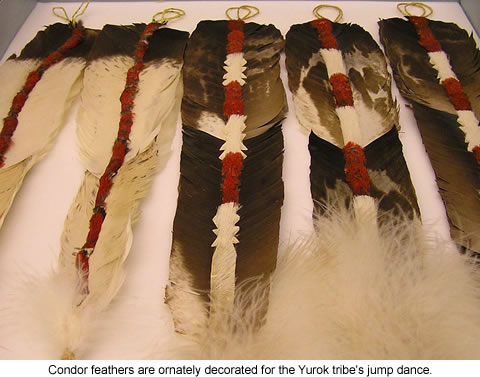 |
Canku Ota
|
 |
|
(Many Paths)
|
||
|
An Online Newsletter
Celebrating Native America
|
||
|
September 1, 2010 -
Volume 8 Number 9
|
||
|
|
||
|
Yurok Indians Exult
At Return Of Sacred Cache
|
||
|
by Peter Fimrite - San
Francisco (CA) Chronicle Staff Writer
|
||
|
credits: Photos Courtesy
of Yurok Tribe
|
|
The Smithsonian Institution has returned a trove of precious artifacts to the Yurok Indians in California in what is one of the largest repatriations of Native American ceremonial artifacts in U.S. history. The Yurok, who have lived for centuries along California's Klamath River, received 217 sacred items that had been stored on museum shelves for nearly 100 years. The necklaces, headdresses, arrows, hides and other regalia from the Smithsonian's National Museum of the American Indian are believed to be hundreds, if not thousands, of years old.
To celebrate the return of the items, the Yurok will hold a Kwom-Shlen-ik, or "Object Coming Back," ceremony today in the town of Klamath. The returned artifacts were sold to the museum in the 1920s by Grace Nicholson, a renowned collector of Indian art, who owned a curio shop in Pasadena in the early 20th century. Ceremonial Indian regalia was in vogue among wealthy Americans at the time. The sacred cache is part of an ongoing effort around the country to return Native American burial artifacts, ceremonial items and remains taken by white settlers from Indian villages and indigenous sites. Repatriating
belongings Among the items claimed by the Yurok were finely woven baskets, wolf headdresses, eagle and California condor feathers, head rolls made from pileated woodpecker scalps, white deer skins, obsidian blades and flint, all of which have been used for centuries in sacred rituals and dances. "If we were to study or use scientific methods for testing we could probably come up with some rough dates, but generally they are made of materials that aren't readily available anymore," said Buffy McQuillen, the repatriation coordinator for the Yurok. Many of the items, for instance, are woven together using fibers from iris, a local plant that is now rare in the area. Also difficult, if not impossible, to find today are woodpecker scalps, condor feathers and white deer skin, apparently from rare albino-type deer, McQuillen said. "They are definitely old," she said. "They were acquired in the early 1900s, but they were in use and practice many years before that." O'Rourke said the items will be used beginning Aug. 27 in the tribe's White Deerskin Dance, a ceremony designed to give thanks for what nature has provided to the people. They will also be used starting Sept. 24 in the Jump Dance, another traditional ceremony that asks the creator for balance and renewal. The dancers perform nine abreast in full regalia for 10 days, primarily inside a traditional redwood plank house. "We are getting (the returned items) ready to dance. They are going to work," O'Rourke said. "It's been a long time since they've heard their native voices and native songs."
At one time there were more than 50 villages in the tribe's ancestral territory, which covered about 500,000 acres and 50 miles of coastline. The Yurok, who called themselves Oohl, or Indian people, were renowned for fishing, canoe making, basket weaving, story telling and dancing. The Yurok were first visited by the Spanish in the 1500s and later by American fur traders and trappers, including Jedediah Smith, who raved about the abundant wildlife in the area. In 1850, gold miners moved in, bringing with them disease and violence. The Yurok population declined by 75 percent, and the remaining Indians were forcibly relocated to a reservation in 1855. Javier Kinney, a tribal leader who was one of four Yurok selected to go to Washington, D.C., to pick up the ceremonial regalia, said the returned items signify a new beginning. "Our responsibilities are to preserve our culture, our language and our religious beliefs not only for us, but for our children and their children," Kinney said. "This signifies a new day for the Yurok. We're not a people of the past that are only in history books." The returned items make up 30 percent of the National Museum's Yurok holdings. |
|
|
||
|
|
||
| Canku Ota is a free Newsletter celebrating Native America, its traditions and accomplishments . We do not provide subscriber or visitor names to anyone. Some articles presented in Canku Ota may contain copyright material. We have received appropriate permissions for republishing any articles. Material appearing here is distributed without profit or monetary gain to those who have expressed an interest. This is in accordance with Title 17 U.S.C. Section 107. | ||
|
Canku Ota is a copyright ©
2000, 2001, 2002, 2003, 2004, 2005, 2006, 2007, 2008, 2009, 2010
of Vicki Barry and Paul Barry.
|
||
 |
 |
|
|
The "Canku
Ota - A Newsletter Celebrating Native America" web site and
its design is the
|
||
|
Copyright ©
1999, 2000, 2001, 2002, 2003, 2004, 2005,
2006, 2007, 2008, 2009, 2010
of Paul C. Barry.
|
||
|
All Rights Reserved.
|
||
 "It's
awesome. It's a big thing with our people," said Thomas O'Rourke,
chairman of the Yurok, a tribe that lived next to the Klamath River
in far Northern California for 10,000 years before Europeans arrived.
"These are our prayer items. They are not only symbols, but
their spirit stays with them. They are alive. Bringing them home
is like bringing home prisoners of war."
"It's
awesome. It's a big thing with our people," said Thomas O'Rourke,
chairman of the Yurok, a tribe that lived next to the Klamath River
in far Northern California for 10,000 years before Europeans arrived.
"These are our prayer items. They are not only symbols, but
their spirit stays with them. They are alive. Bringing them home
is like bringing home prisoners of war." Largest
tribe
Largest
tribe